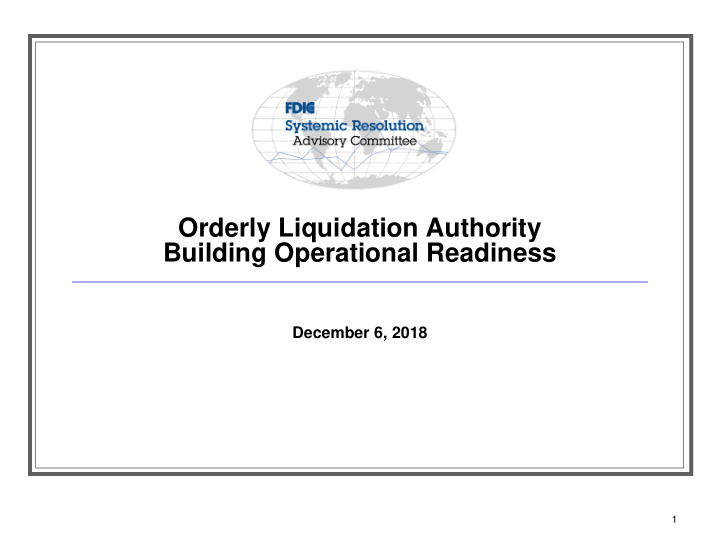



Orderly Liquidation Authority Building Operational Readiness December 6, 2018 1
Overview Orderly Liquidation Authority (OLA) resolution planning benefits significantly from the Title I process The FDIC has established a comprehensive program for building and maintaining execution readiness Increased awareness among market participants and other members of the public of how an OLA resolution would unfold could enhance the effectiveness of the authority should it be needed 2
Role of OLA in U.S. Resolution Regime Extends resolution tools similar to the FDIC’s longstanding bank resolution authorities to non-bank financial companies—e.g., bridge authority, liquidity facility Serves as a backstop to bankruptcy where necessary to curtail systemic risk to the U.S. financial system The OLA report reaffirms that bankruptcy is the “resolution method of first resort” For Title I plan filers, OLA would leverage certain plan elements including processes for executing an SPOE strategy and firm capabilities Statute prohibits costs to taxpayers and provides funding strictly for temporary liquidity support Losses are borne by equity holders and impaired creditors Backstop funding through the Orderly Liquidation Fund (OLF) is available if needed to assure continuity of critical operations and minimize risk of systemic impact (industry assessment available, if necessary, to repay OLF borrowing) 3
Treasury Report Recommendations on Improving OLA There are a number of important recommendations in the Treasury report, particularly those that further improve public transparency Specific recommendations from the OLA Report that we will be closely considering include: Finalizing SPOE notice for comment Further restricting disparate treatment of similarly situated creditors Further protecting OLF advances from the risk of loss 4
Progress Addressing Core Challenges • Development of SPOE Multiple competing • Loss-absorbing capacity, including pre-positioned and contributable insolvencies resources • Firms’ liquidity forecasting models (Resolution Liquidity Adequacy & Funding and liquidity Positioning (RLAP), Resolution Liquidity Execution Need (RLEN)) Operations and • Legal entity rationalization interconnectedness • Shared services framework • ISDA Protocol, addressing stays for cross-border Qualified Financial Contracts (QFCs) Counterparty actions • Financial Market Utility (FMU) continuity playbooks, addressing additional margin requirements • Regular formal and informal engagement with host authorities in a variety of fora Global coordination • Establishment of shared expectations and coordination protocols that reduce risk of destructive “ring fencing” 5
Systemic Resolution Readiness Program • Operational Exercise 1 (2015) Systemic Resolution • Operational Exercise 2 (2016) Framework • Principal-Level Exercises (about every two years) Primary actions across core functional areas • Focused inter-agency exercises, workshops, and ongoing collaboration Process Documents and (e.g., 3-keys, funding) Testing • Bi-lateral and multi-lateral cross-border Playbooks, process playbook exercises documents, templates, reference documents • Internal FDIC execution readiness exercises • Title I plan reviews Institution-Specific Planning • Firm-specific strategic OLA analysis (annual) Strategic alternatives, operational considerations, cross-border coordination • Cross-border Crisis Management Groups (annual) 6
OLA Processes Supported by Firm Capabilities Established Through Title I Mapping recovery and resolution actions through “runway” Governance mechanisms and associated triggers provide another tool for assessing the trajectory of a firm’s condition across the crisis continuum, and for anticipating associated actions Addressing capital needs at material entities Resolution Capital Adequacy & Positioning (RCAP) and Resolution Capital Execution Need (RCEN) modeling calculate and position loss-absorbing resources in the locations most needed, and serve as a basis for determining recapitalization needs Projecting liquidity stresses across the group RLAP and RLEN modeling assess the factors that drive liquidity stresses and project the location and timing of liquidity needs Delivery of communications Communications playbooks can be leveraged to deliver messaging to the broad array of stakeholders that must be reached upon entry into resolution—firm personnel, counterparties, customers etc. Other Continuity of access to FMUs (FMU playbooks) Continuity of shared services (resolution-friendly contracts, working capital) Retention of key operational staff (retention plans) Objects of sale (divestiture playbooks, data rooms) 7
Bridge Governance Balanced Approach Approval of: Orderly Liquidation Plan (OLP) for reorganization of the Bridge Amendments to articles of association and bylaws FDIC retains Bridge Board of Directors Appointment of CEO or other designated senior executive officers certain key controls Material divestitures Any mergers, consolidation or reorganization of Bridge Oversight of funding plan, including approach to use of Orderly Liquidation Fund (OLF) Independent auditor, valuation consultant Manage operations consistent with governing documents and OLP New Bridge Board Continued oversight of subsidiaries, which continue to operate under their and CEO oversee existing governance and regulatory structures Retain approved contractors for asset valuation and audits day-to-day Manage funding and make intercompany advances operations Hire and terminate officers and employees (other than designated key officers) 8 8
Transparency and Engagement Transparency efforts undertaken to date Public portions of Title I plans and letters SRAC – open to public Outreach to rating agencies Speeches and other public statements Notice in the Federal Register - Single Point of Entry OLA is addressed in various public rules and regulations Future priorities U.S. Department of the Treasury (UST) report recommendations Further industry outreach and vetting of processes Deepening and broadening international engagement 9
Recommend
More recommend